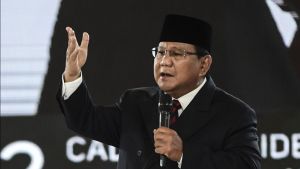JAKARTA - 1740 was a terrible period for ethnic Chinese in the Dutch East Indies. In that year the Vereenigde Oostindische Compagnie (VOC) pursued a policy of reducing the number of ethnic Chinese which led to bloodshed. The ethnic Chinese rebellion broke out. Kapitan Khe Panjang or Kapitan Sepanjang emerged as the leader of the rebellion.
Since 1619, when the City of Batavia was founded, Batavia's population was very diverse. From Europeans, Chinese, natives, to Japanese people. Chinese one of the largest. It's hard to know their specific number at that time. What is clear is that in 1739, one year before the Geger Pacinan tragedy, the number of ethnic Chinese counted at 4,389, consisting of men and women. Adults or children.
In 1740, that number jumped to 10,574 people. As quoted by Leo Suryadinata in the Chinese State and Minority in Indonesia, this surge made the Dutch East Indies government implement strict regulations through various systems.
For example, the officer system was used to monitor the number of the Chinese population. From this system, a community group called Kapitan Cina was formed. Kapitan Cina is a Chinese person who was given a position by the Dutch East Indies government to regulate Chinese affairs based on customary law. Kapitan Cina also takes care of all the administrative needs of the population and tax collection for the government.
The second is the settlement system. Chinese people must live in certain areas that have been determined by the government. Their life in the area was also monitored by the Chinese Kapitan. The Chinese people were prohibited from living with the natives. The separation of the population was further exacerbated by the existence of a status system, in which the residents of Batavia City were divided according to their religion.
Early in 1740, the Chinese in Batavia were increasingly treated discriminatively. Those who wanted to enter Batavia had to have a permit in the form of an entry card (pennissiebriefte). Often Chinese people who were caught were detained because they did not have an entry permit. In addition, many of them were tortured and confiscated by Dutch East Indies officials. Usually, they are only released when they have paid the fine.

This discriminatory attitude continued and slowly burned the embers of revenge against the Dutch East Indies government. The resistance of the Chinese people gradually awakened. To prevent the spread of resistance, on July 25, 1740, a resolution was issued which applied equally to all Chinese.
The content of the resolution was an arrest order against any Chinese resident who was suspected of being against. They were also sent to Ceylon to work on VOC-owned plantations. The reaction of the Chinese population was getting harsher because there were rumors that prisoners who were to be sent to Ceylon would usually be dumped at sea.
The turmoil was exacerbated by increasing unemployment. Criminal action is rampant because many Chinese people - who used to work in sugar factories - have to lose their jobs because the sugar factories are closed. At that time, the Dutch East Indies experienced a decline in sugar demand for European exports.
The various factors above triggered hatred of Chinese citizens against the government. This was also the reason for the outbreak of the Geger Pacinan incident on October 9, 1740. Quoted by Johannes Theodorus Vermeulen in Chinese in Batavia in October 1740, the rebellion and protests of Chinese citizens were responded to by the Dutch East Indies government by massacring them and burning their houses.
Kapitan Command Khe PanjangThe Chinese resistance in Batavia was led by Oey Panko, better known as Khe Panjang or Kapitan Sepanjang. In the historical literacy sequence, Kapitan Khe Panjang seems to have suddenly appeared. So little information about the background can be extracted. Historian Ravando Lie agrees.
"Kapitan Throughout this is indeed unique and needs further investigation, especially from the VOC archives. Kapitan's background So far, it seems that there have not been many kidnappers. The books that review Geger Pacinan do not seem to provide a portion for his background. This could be because it is true. lack of resources, "the man who is now a doctoral candidate in history at the University of Melbourne, told VOI, Tuesday, November 12.
Although there is no clear explanation regarding Kapitan Sepanjang's background, his resistance to the rioting that killed tens of thousands of Chinese cannot be underestimated. As a result of being beaten back, Kapitan Sepanjang and his troops fled to Bekasi to gather strength.
The pursuit of Kapitan Sepanjang who continued against the Dutch East Indies government continued until the following year. June 1741, VOC troops consisting of 150 European soldiers, 250 Indigenous soldiers, and one hundred navy were dispatched to Bekasi to attack the defenses of the Chinese who were considered to be rebellious.
Over the course of two weeks, the pursuit of Kapitan Sepanjang killed many Bekasi residents. The place where Kapitan Sepanjang used to stay and his troops were burned down. However, Kapitan Sepanjang and his four hundred troops managed to escape the ambush by fleeing towards Mount Priangan.

Johannes Theodorus Vermeulen, in his book Tionghoa in Batavia and Huru-Hara 1740, tells how Kapitan Sepanjang continued to encourage his troops even though the Dutch continued to push. In fact, if any of the troops slacked off or intended to surrender from the resistance, they would be beheaded.
In the next movement, Kapitan Sepanjang formed a coalition with Raden Mas Said alias Pangeran Sambernyawa, Raden Mas Garendi - who later became king with the title Sunan Kuning or Amangkurat V, and Patih Notokusumo to foment resistance against the VOC in the Mataram area.
The unity of these troops was a terrible threat to the VOC's strength, it was even considered a portrait of diversity. The founder of the Peranakan Tionghoa Library Museum, Azmi Abu Bakar, said that this portrait of diversity is a step of high solidarity between Javanese and Chinese ethnicities.
"It is truly extraordinary that our collective understanding is far behind our ancestors in the past. Even the war was said to be a war of jihad, it was commanded by Kapitan Sepanjang who was not a Muslim," said Azmi.
This unity of two ethnic forces waged war in almost all regions of Central Java and East Java. As a result, the cities of Jepara, Kudus, Rembang, Demak were captured by the Chinese Army and Javanese Soldiers. Even the Kapitan Sepanjang led Chinese and Javanese troops to attack the Mataram Palace in Surakarta and managed to seize the Kartasura Palace which forced Sunan Pakubuwono II to run away from the palace to the Magetan region.
In fact, initially Sunan Pakubuwono II sided with Kapitan Sepanjang and the Chinese Laskar, but he turned to support the VOC in 1742, causing disappointment both from the Chinese Laskar and the patih and regents under Sunan's rule. They ignored orders and preferred to fight the VOC with Kapitan Sepanjang.
Raden Mas Garendi has been named as the successor of Sunan Pakubuwono II with the title Sunan Amangkurat V Senopati Ing Alaga Abdurahman Sayidin Panatagama. Quoted from the book Geger Chinatown by Daradjadi, Raden Mas Garendi was also nicknamed Sunan Kuning, this was interpreted because he was a king who had a yellow-skinned army against the VOC.
Meanwhile, Kapitan Sepanjang was trusted to be a teacher for warlords by Sunan Kuning. But Sunan Amangkurat V did not last long in power. At the end of 1742, the VOC army together with the troops of the Madura Regent Cakraningrat managed to reclaim the Kartasura Palace.
Losing in the attack, finally Sunan Amangkurat V retreated to the east along with Kapitan Sepanjang and Laskar Tionghoa. They continued their resistance and fought, unfortunately Amangkurat V and Kapitan Sepanjang separated because Amangkurat V was caught in Surabaya in December 1743 and exiled to Sri Lanka.
Meanwhile, Kapitan Sepanjang continued to fight against the VOC and then ran across to Bali and served in a kingdom in Bali, since then his name was never heard from again, there is no historical record of his movement in Bali. Gaitnya and the Chinese Laskar who fought throughout his life, also buried.
The English, Chinese, Japanese, Arabic, and French versions are automatically generated by the AI. So there may still be inaccuracies in translating, please always see Indonesian as our main language. (system supported by DigitalSiber.id)









